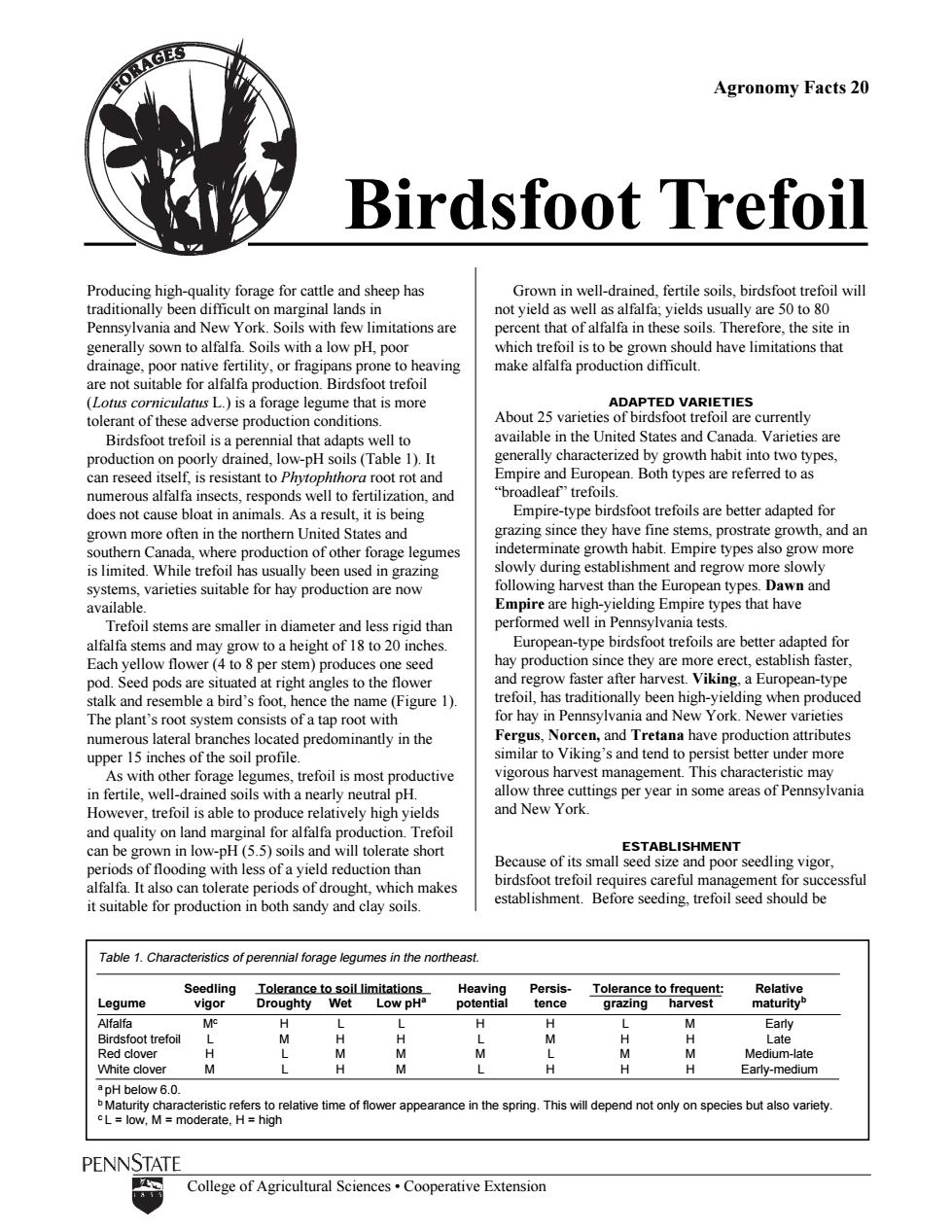正在加载图片...

RAGES Agronomy Facts 20 Birdsfoot Trefoil Pennsylvania and New York.Soils with few limitations are generally sown to alfalfa.Soils with a low pH,poor which trefoil is to be grown should have limitations that arainage,poor native eduction Birdsfoot trefoil make alfalfa production difficult. tolerant of these adverse production conditions. Birdsfoot trefoil is a perennial that adapts well to Statesand Varieties are poorly draind,ow-(Table 1).It rpDotyrreredo and does not cause bloat in animals.Asa result,it is being Empire-type bi grown more ofen in the northern United States and urnsblishmntr Cmpire are high-y ngEmpire types that have and less rigid than 0& 8to20 ncne European-type birdsfoot better adapted for hay production since they are more erect,establish faster. pod.Seed pods are situated at to the ower wfaster after harves iki ga European-type stalk and resemble a bird's foot ence the name(Figure 1). The plant's ro in the Fergus,Norcen,and Tretana have production attributes similar to Viking's and tend to persist better under more As with other forage legumes,trefoil is most productive I pH and New York own in low-pH (55)soils and will tolerate short birdsfoot trefoil requires careful management fors essful establishment.Before seeding.trefoil seed should be sandy and Table 1.Characteristics of p nial forage legumes in the northeast cgume White clover pH below6.0. tive time of f ower appearance in the spring.Thisv epend not only on species but also variety PENNSTATE College of Agricultural SciencesCooperative Extension College of Agricultural Sciences • Cooperative Extension Birdsfoot Trefoil Grown in well-drained, fertile soils, birdsfoot trefoil will not yield as well as alfalfa; yields usually are 50 to 80 percent that of alfalfa in these soils. Therefore, the site in which trefoil is to be grown should have limitations that make alfalfa production difficult. ADAPTED VARIETIES About 25 varieties of birdsfoot trefoil are currently available in the United States and Canada. Varieties are generally characterized by growth habit into two types, Empire and European. Both types are referred to as “broadleaf” trefoils. Empire-type birdsfoot trefoils are better adapted for grazing since they have fine stems, prostrate growth, and an indeterminate growth habit. Empire types also grow more slowly during establishment and regrow more slowly following harvest than the European types. Dawn and Empire are high-yielding Empire types that have performed well in Pennsylvania tests. European-type birdsfoot trefoils are better adapted for hay production since they are more erect, establish faster, and regrow faster after harvest. Viking, a European-type trefoil, has traditionally been high-yielding when produced for hay in Pennsylvania and New York. Newer varieties Fergus, Norcen, and Tretana have production attributes similar to Viking’s and tend to persist better under more vigorous harvest management. This characteristic may allow three cuttings per year in some areas of Pennsylvania and New York. ESTABLISHMENT Because of its small seed size and poor seedling vigor, birdsfoot trefoil requires careful management for successful establishment. Before seeding, trefoil seed should be Table 1. Characteristics of perennial forage legumes in the northeast. Seedling Tolerance to soil limitations Heaving Persis- Tolerance to frequent: Relative Legume vigor Droughty Wet Low pHa potential tence grazing harvest maturityb Alfalfa Mc H L L H H L M Early Birdsfoot trefoil L M H H L M H H Late Red clover H L M M M L M M Medium-late White clover M L H M L H H H Early-medium a pH below 6.0. b Maturity characteristic refers to relative time of flower appearance in the spring. This will depend not only on species but also variety. c L = low, M = moderate, H = high Agronomy Facts 20 Producing high-quality forage for cattle and sheep has traditionally been difficult on marginal lands in Pennsylvania and New York. Soils with few limitations are generally sown to alfalfa. Soils with a low pH, poor drainage, poor native fertility, or fragipans prone to heaving are not suitable for alfalfa production. Birdsfoot trefoil (Lotus corniculatus L.) is a forage legume that is more tolerant of these adverse production conditions. Birdsfoot trefoil is a perennial that adapts well to production on poorly drained, low-pH soils (Table 1). It can reseed itself, is resistant to Phytophthora root rot and numerous alfalfa insects, responds well to fertilization, and does not cause bloat in animals. As a result, it is being grown more often in the northern United States and southern Canada, where production of other forage legumes is limited. While trefoil has usually been used in grazing systems, varieties suitable for hay production are now available. Trefoil stems are smaller in diameter and less rigid than alfalfa stems and may grow to a height of 18 to 20 inches. Each yellow flower (4 to 8 per stem) produces one seed pod. Seed pods are situated at right angles to the flower stalk and resemble a bird’s foot, hence the name (Figure 1). The plant’s root system consists of a tap root with numerous lateral branches located predominantly in the upper 15 inches of the soil profile. As with other forage legumes, trefoil is most productive in fertile, well-drained soils with a nearly neutral pH. However, trefoil is able to produce relatively high yields and quality on land marginal for alfalfa production. Trefoil can be grown in low-pH (5.5) soils and will tolerate short periods of flooding with less of a yield reduction than alfalfa. It also can tolerate periods of drought, which makes it suitable for production in both sandy and clay soils